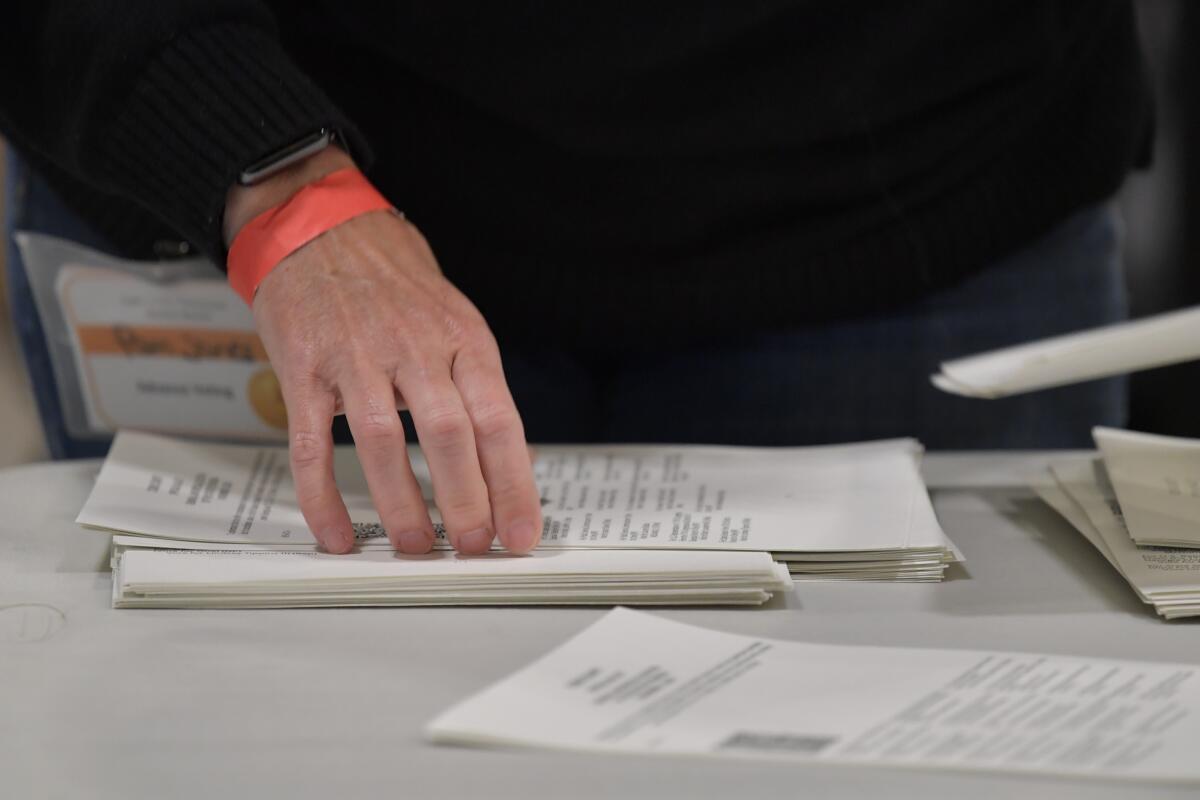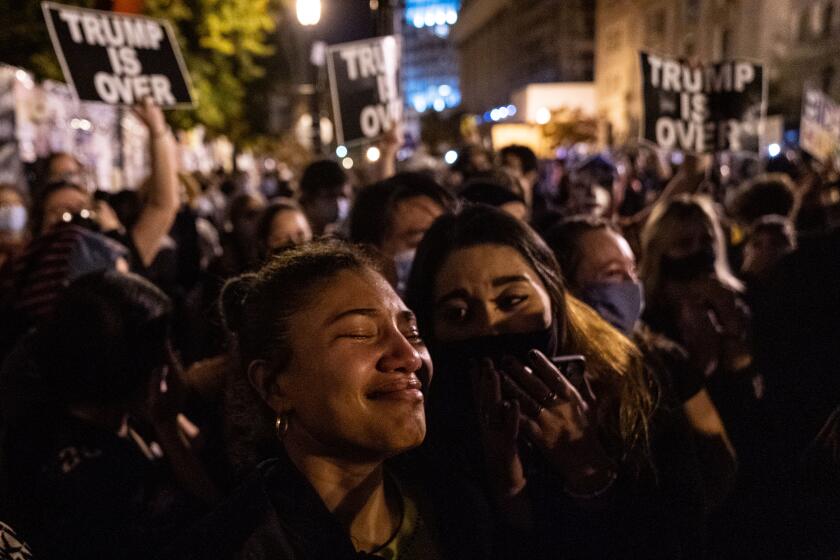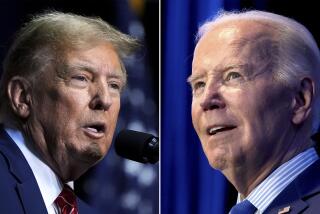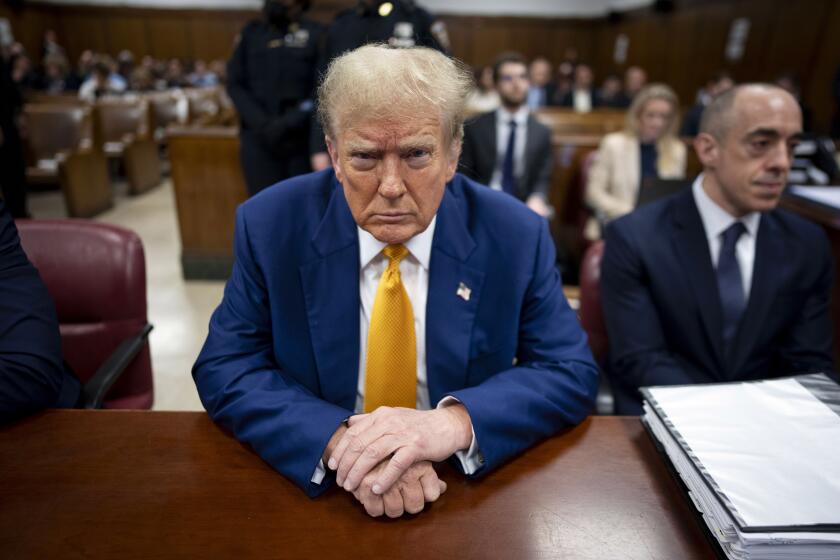As Trump attacks election outcome, Americans are less confident in the vote count, USC poll finds

President Trump’s repeated — and baseless — insistence that widespread fraud undermined this month’s presidential election has left a mark on Americans’ faith in the voting process, a postelection USC Dornsife survey has found.
Using a 0-100 scale to measure their confidence that all ballots were tallied correctly, the survey found that the average ranking from voters was a middling 58. Democrats gave higher marks — 79 — that the vote count was accurate, while Republicans on the whole rated their confidence in the election results’ accuracy at just 34.
“What’s really very clear is that the large group of voters who voted for Donald Trump in this election have absorbed the message that the vote may not have been completely, fairly counted,” said Jill Darling, the director of the USC Dornsife survey. Democrats, she said, may have lost confidence because of concerns about voter suppression or problems with the U.S. Postal Service.
The final preelection tracking poll estimated a national electoral outcome of Joe Biden with 53% of the popular vote and Trump with 44%. The actual results were a narrower spread: Biden with 51% and Trump getting 47%, with results still being tallied.
“Clearly, we were overestimating Biden a little bit and underestimating Trump by a little bit more,” Darling said.
To explain the discrepancy, Darling said the USC team has begun to look into whether its probability questions, in which respondents ranked their answers on a scale of 0 to 100, did not work as well this election year or if it was missing any key population of voters. The team’s analysis found that the survey did do a good job of predicting overall likelihood of voting. It also found no evidence that people lied or were inconsistent in their responses.
President-elect Joe Biden won his race by performing strongly in suburbs, building large margins among Black voters and chipping into Trump territory.
One possible reason for the polling miss could be the deep polarization in the electorate.
“We used to get a range of what people would say about their likelihood of voting for each candidate. This election, everyone was clustered at either 0 or 100 — yes or no,” Darling said. “The question is: Is that just what the electorate looks like now or are people who are still making up making up their minds a missing piece of the puzzle.”
Other factors that could account for the results could be that young respondents tended to overstate their likelihood of voting, some voters stopped participating for the duration of the tracking survey and people who decided their vote on the day of the election slightly favored Trump.
Many other polls this cycle also tended to underrate support for Trump, raising expectations for a commanding Biden win coupled with a blue wave of Democratic wins down-ballot. While Biden did receive a record-setting 79 million votes so far, Democrats fell short in key Senate races and lost seats in the House of Representatives, although they maintained a majority.
Just before the election, for example, the USC Dornsife poll estimated a double-digit win for Biden. However, a separate question about how voters thought their friends, family and acquaintances may vote pointed to a tighter race — 51% for Biden versus 46% for Trump — that more closely aligned with the true results.
Henrik Olsson, an external professor at the Santa Fe Institute who is researching this social circle line of inquiry, said one reason for the question’s success could be that it is “a way of couching unpopular or embarrassing opinions among voters.”
In addition to providing cover for “shy Trump voters” to share their sentiments, the question “may be implicitly including people who are not answering to the poll,” said Wandi Bruine de Bruin, provost professor of Public Policy, Psychology and Behavioral Science at USC.
“If there are Trump voters who don’t want to talk to pollsters, we may get information about them from their contacts who are in the poll,” she said.
The postelection poll, which was weighted to reflect the results, also sheds insight into how Biden stitched together his win. The demographic findings, which were re-weighted to reflect the actual results, pointed to a stronger performance for the Democrat among men, 46% of whom sided with Biden while 52% went for Trump. In 2016, Trump had a 12-point advantage with men. Biden’s 15-point margin with women was similar to Hillary Clinton’s edge four years ago.
Those findings differ from what was found in some exit polls. Darling noted that the USC survey talks to the same respondents before and after the election, offering them a “very solid way to compare” the data. She also noted that across all polls, the demographic subgroups can be small, leading to a larger margin of error.
“Everybody’s methods are a little bit different,” Darling said.
Trump won among white voters with a slightly narrower margin than he did in 2016, the survey said, and trailed with Black voters to a similar extent as he did four years ago. He won 33% of the Latino vote, according to the findings, marking a very slight uptick within the margin of error compared with when he won 30% against Clinton.
While some preelection surveys projected a strong performance for Biden with senior citizens, the USC poll found that Trump increased his margin among that group from 2 points in 2016 to 6 in 2020.
Biden, however, was buoyed by a 15-point lead with Generation Z and millennial voters.
“It’s ironic that the oldest president in American history was elected by the youngest segment of electorate,” said Bob Shrum, a veteran Democratic strategist who directs USC’s Center for the Political Future, which co-sponsors the poll.
Trump performed best among voters who said their top issues were jobs and the economy, preserving American democracy, and law and order.
Both the economy and “law and order” were major themes of Trump’s campaign, and though he didn’t explicitly talk about democracy much on the trail, his frequent accusations that the Democrats were socialists appeared to resonate with his voters, Darling said.
Biden won among those who were most concerned about the coronavirus crisis, candidate integrity, healthcare, uniting the country and civil rights.
Only 35% of respondents said they believed the country was headed in the right direction, a nearly 10-point drop from 2016. The outlook varied by party, reflecting the hyperpolarized electorate — more than three-quarters of Biden voters said they thought the country was on the wrong track before the race was called for him, but after he was declared president-elect, 60% of Biden supporters said they believed the country was headed in the right direction.
In the immediate aftermath of the election, 56% of Trump voters said the country was on the wrong track; that glum view increased to 76% of Trump supporters after the race was called for Biden.
The partisan divide extended to attitudes toward voting by mail. Nearly three-quarters of Trump supporters said the increase in mail-in ballots led to voter fraud, while nearly 80% of Biden supporters disagreed.
Shrum said the shaken confidence in the voting system should be a paramount focus for pollsters and political experts going forward.
“If people lose faith in the fundamentals in the political process — in the fairness of their vote, the way the democracy works — then you have to think the country will end up in very big trouble,” he said.
The USC Dornsife Daybreak 2020 tracking poll and postelection poll are joint projects of the University of Southern California’s Dornsife Center for Economic and Social Research and the Dornsife Center for the Political Future. The survey, conducted Nov. 4-15, consisted of 6,285 adult U.S. residents, 5,102 of whom voted in the presidential election. Among the respondents were more than 5,500 who participated in USC’s daily tracking poll, which has measured voter sentiment since from August through the day before election day.
Results of the postelection poll are weighted to reflect U.S. Census Bureau figures for demographic characteristics, as well as 2020 vote estimates from the Associated Press and the Cook Political Report. The estimated error range for the poll’s full sample of presidential election voters is roughly 1 percentage point in either direction.
A complete description of the poll’s methodology, along with the text of the questions asked and the full data tables, is available on the USC Dornsife website.
More to Read
Get the L.A. Times Politics newsletter
Deeply reported insights into legislation, politics and policy from Sacramento, Washington and beyond. In your inbox three times per week.
You may occasionally receive promotional content from the Los Angeles Times.








